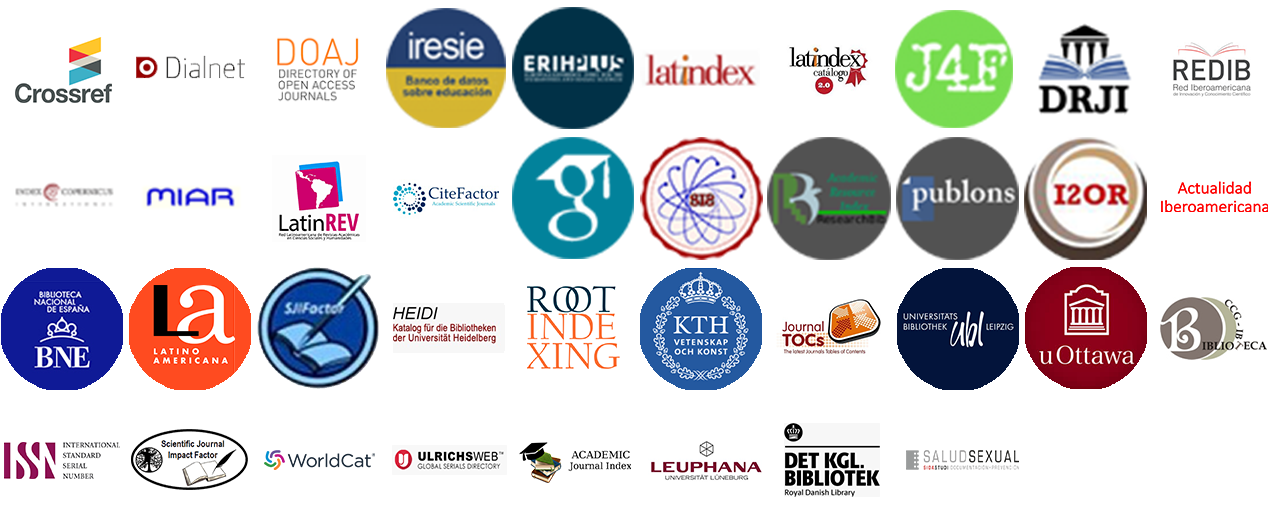Study and simulation of PAPR reduction techniques in HACO-OFDM
DOI:
https://doi.org/10.36825/RITI.09.17.005Keywords:
PAPR, HACO-OFDM, CE-POCS, OPS, SAPAbstract
VLC (Visible Light Communications) have been recently proposed as a new form of wireless communications. The VLC advantages are its usage of the spectrum of visible light which is not licensed; additionally, it gives high data rates, protects the user against espionage and does not suffer from interference of the electromagnetic spectrum. One of the main techniques used in VLC is HACO-OFDM (Hybrid Asymmetrically Clipped Optical - Orthogonal Frequency Division Multiplexing), which offers a high spectral efficiency. However, one of its main problems is its high PAPR (Peak-to-Average-Power Ratio). This article presents a study and simulation of Clipping, CE-POCS (Constellation Extension – Project Onto Convex Sets), OPS (Orthogonal Pilot Sequences) and SAP (Simple Amplitude Predistortion) techniques for the reduction of the PAPR in HACO-OFDM systems. The simulation results show that the SAP technique gives the best results in PAPR reduction without significant degradation in the BER (Bit Error Rate).
References
Afgani, M. Z., Haas, H., Elgala, H., Knipp, D. (2006). Visible Light Communication Using OFDM. Trabajo presentado en International Conference on Testbeds and Research Infrastructures for the Development of Networks and Communities, Barcelona, España. doi: https://doi.org/10.1109/TRIDNT.2006.1649137
Hossain Mondal, M. R., Binte Faruque, R. (2017). Hybrid diversity combined OFDM for LiFi. Trabajo presentado en IEEE International Conference on Telecommunications and Photonics (ICTP), Dhaka, Bangladesh. doi: https://doi.org/10.1109/ICTP.2017.8285945
Dimitrov, S., Sinanovic, S., Haas, H. (2012). Signal Shaping and Modulation for Optical Wireless Communication. Journal of Lightwave Technology, 30 (9), 1319-1328. doi: https://doi.org/10.1109/JLT.2012.2188376
Wang, J., Xu, Y., Ling, X., Zhang, R., Ding, Z., Zhao, C. (2016). PAPR analysis for OFDM visible light communication. Optics Express, 24 (24), 27457-27474. doi: https://doi.org/10.1364/OE.24.027457
Binita, A., Hema, P. (2019). Reduction of PAPR in HACO OFDM Signals using PTS Schemes. Trabajo presentado en 2nd International Conference on Intelligent Computing, Instrumentation and Control Technologies (ICICICT), Kannur, Kerala, India. doi: https://doi.org/10.1109/ICICICT46008.2019.8993379
Li, B., Xu, W., Zhang, H., Zhao, C., Hanzo, L. (2017). PAPR Reduction for Hybrid ACO-OFDM Aided IM/DD Optical Wireless Vehicular Communications. IEEE Transactions on Vehicular Technology, 66 (10), 9561-9566. doi: https://doi.org/10.1109/TVT.2017.2698265
Perarasi, T., Vidhya, S., Hemavikasini, S., Vakula, V., Varsha, H. (2020). LI-FI based Peak to Average Power Ratio Reduction in HACO-OFDM System. Trabajo presentado en Fourth International Conference on Computing Methodologies and Communication (ICCMC), Erode, India. doi: https://doi.org/10.1109/ICCMC48092.2020.ICCMC-00090
Ranjha, B., Kavehrad, M. (2016). Hybrid asymmetrically clipped OFDM-based IM/DD optical wireless system. IEEE/OSA Journal of Optical Communications and Networking, 6 (4), 387-396. doi: https://doi.org/10.1364/JOCN.6.000387
Islim, M. S., Haas, H. (2016). Modulation techniques for Li-Fi. ZTE Communications, 14 (2), 29-40.
Paredes Paredes, M. C., Fenández-Getino García, M. J. (2015). The problem of PAPR in OFDM systems. Department of Signal Theory and Communications. Universidad Carlos III de Madrid. Spain. Recuperado de: https://arxiv.org/pdf/1503.08271.pdf
Cho, Y. S., Kim, J., Young Yang, W., Kang, C. G. (2010). PAPR Reduction. En Y. S. Choo, J. Kim, W. Young Yang, C. G. Kang (Eds.) MIMO-OFDM Wireless Communications with MATLAB® (pp. 209-250). India: John Wiley & Sons.
Ann, P. P., Jose, R. (2016). Comparison of PAPR reduction techniques in OFDM systems. Trabajo presentado en International Conference on Communication and Electronics Systems (ICCES), Coimbatore. doi: https://doi.org/10.1109/CESYS.2016.7889995
Li, X., Cimini, L. J. (1998). Effects of clipping and filtering on the performance of OFDM. IEEE Communications Letters, 2 (5), 131-133.
Krongold, B. S., Jones, D. L. (2003). PAR reduction in OFDM via active constellation extension. IEEE Transactions on Broadcasting, 49 (3), 258-268.
Jones, D. L. (1999). Peak power reduction in OFDM and DMT via active channel modification. Trabajo presentado en Conference Record of the Thirty-Third Asilomar Conference on Signals, Systems, and Computers (Cat. No.CH37020), Pacific Grove, CA, USA. doi: https://doi.org/10.1109/ACSSC.1999.831875
Fernandez-Getino Garcia, M. J., Edfors, O., Paez-Borrallo, J. M. (2006). Peak power reduction for OFDM systems with orthogonal pilot sequences. IEEE Transactions on Wireless Communications, 5 (1), 47-51.
MathWorks. (2020). Soporte. Recuperado de: https://la.mathworks.com/support.html?s_tid=gn_supp
Sezginer, S., Sari, H. (2006). OFDM peak power reduction with simple amplitude predistortion. IEEE Communications Letters, 10 (2), 65-67.
Sezginer, S., Sari, H. (2007). Metric-Based Symbol Predistortion Techniques for Peak Power Reduction in OFDM Systems. IEEE Transactions on Wireless Communications, 6 (7), 2622-2629.
León Carrillo, D. J. (2018). Estudio y simulación de las técnicas DCO-OFDM, ACO-OFDM y HACO-OFDM para la tecnología Li-Fi en ambientes indoor (Tesis de Grado), Escuela Politécnica Nacional, Quito. Recuperado de: https://bibdigital.epn.edu.ec/handle/15000/19647
Quilumba Toapanta, L. A. (2017). Simulación de la técnica Constellation Extension de reducción de la PAPR de los sistemas OFDM (Tesis de Grado). Escuela Politécnica Nacional, Quito. Recuperado de: http://bibdigital.epn.edu.ec/handle/15000/17071
Peñaherrera Murillo, M. M. (2019). Simulación de la técnica OPS para la reducción de la PAPR en un sistema OFDM con canal Nakagami (Tesis de Grado). Escuela Politécnica Nacional, Quito. Recuperado de: http://bibdigital.epn.edu.ec/handle/15000/20282
Published
How to Cite
Issue
Section
License
Copyright (c) 2021 Revista de Investigación en Tecnologías de la Información

This work is licensed under a Creative Commons Attribution-NonCommercial-NoDerivatives 4.0 International License.
Esta revista proporciona un acceso abierto a su contenido, basado en el principio de que ofrecer al público un acceso libre a las investigaciones ayuda a un mayor intercambio global del conocimiento.
El texto publicado en la Revista de Investigación en Tecnologías de la Información (RITI) se distribuye bajo la licencia Creative Commons (CC BY-NC
 ), que permite a terceros utilizar lo publicado citando a los autores del trabajo y a RITI, pero sin hacer uso del material con propósitos comerciales.
), que permite a terceros utilizar lo publicado citando a los autores del trabajo y a RITI, pero sin hacer uso del material con propósitos comerciales.



